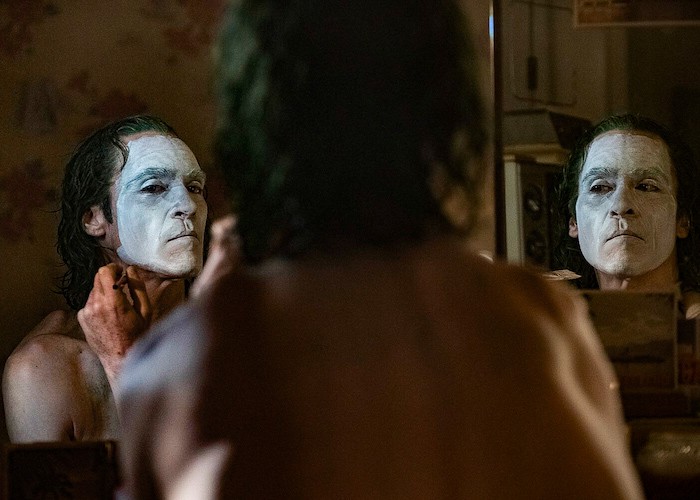
Ending Explained is a recurring series in which we explore the finales, secrets, and themes of interesting movies and shows, both new and old. In this entry, we explore the ending of Joker.
The final scene of Joker is like none other in the rest of the film. Prior to this moment, most of the shots are shellacked with the oozy gloss of ’80s New York City, the nightmare realm of Martin Scorsese’s Mean Streets and Michael Winner’s Death Wish. Director Todd Phillips and cinematographer Lawrence Sher manipulate this era of cinema to heighten the hellscape of their antihero and deliver a Gotham City that feels more emotionally relatable to today’s disenfranchised than any other theatrical adaptation. The world is a garbage heap best left for super rats and requires a cleansing flame to rebuild again. Those in power carefully constructed the dump and deserve internment under its ashes.
But that’s not what we see when Arthur Fleck (Joaquin Phoenix) croons his audience into the end credits.
The wannabe comedian that demanded that his TV idol (Robert De Niro) rechristen him as “Joker” to the national stage before he declared himself as the righteous subway assassin and spun Gotham into a frenzy of riotous rage with a bullet to talk show host Murray Franklin’s eye socket, now sits in a bleached white room across from yet another inquisitive social worker. We do not know how he got here. The last we saw him, Arthur was standing atop a wrecked police car observing the chaos he unleashed while clown-masked acolytes gathered at his feet. He was triumphant, ushering his fellow citizens to a deliverance of madness.
We know he has been in rooms like this before, but where past frustration led him to bash his skull relentlessly upon the wall, Arthur currently rests serenely with a smile stretched across his face. The halo of white does not simply represent the sanitorium. The world of Arkham Asylum that once housed his mother appeared very much aligned to Gotham’s gritty and crumbling aesthetic. There were very few operational halogen bulbs in those ceilings.
Could the blinding whiteness indicate a separate level of reality? I’ve seen this idea bounced around, but I’m not inclined to believe it. Throughout the film, Arthur proves himself to be an unreliable narrator with a delusional knowledge of self regarding the quality of his comedy and an entire hallucinated relationship with the girl next door, Sophie (Zazie Beetz). This does cast a shadow over the narrative. Did Thomas Wayne (Brett Cullen) sock him in the jaw when confronted about his genetic link to Arthur? Did those clown-masked hooligans genuflect to Joker? Because some actions are shown to be fantasy means you cannot take Arthur’s POV at face value. With the visual shift of the last scene, everything before the white room could be considered an extension of a troubled mind.
The only problem is that you’re not actually watching a Joker movie. You’re watching a Batman movie.
The camera is not fixed to Arthur’s POV, and the film features several scenes that drift away from his story. Most significantly, during the climax of the riot, Thomas Wayne rushes his wife Martha (Carrie Louise Putrello) and son Bruce (Dante Pereira-Olson) from a screening of Zorro The Gay Blade. Or, possibly Excalibur, which is another poster featured in the theater window and the movie the Waynes were watching on their fateful night in Batman v Superman: Dawn of Justice. Heck, it could be Arthur or Blow Out, which are also advertised, but knowing the future of the kid, it had to be the masked vigilante movie, right? The comic book lore says it’s gotta be Zorro, and if the ’80s can’t provide Tyrone Power, then the George Hamilton variety will have to do.
As the Waynes retreat through an alleyway, a clown-masked individual skulks behind them. Taking inspiration from Joker’s actions on the subway and Live with Murray Franklin, the 99-percenter guns down Mr. and Mrs. Wayne, leaving Bruce as a helpless witness as two super rats scurry behind him. This time, Joker did not pull the trigger as he did in Batman ’89, but the furor he ignited is just as responsible. So, Todd Phillips may have given Joker his spotlight, but the punchline ultimately belongs to Batman. The entire movie exists in a holding pattern against a well-known continuity of heroism, and while Joker certainly thumbs its nose at that accepted superhero chronicle, it must succumb to its established history.
Back to the white room and Arthur’s surrounding crown of light: the Joker finally knows bliss. A lifetime of anonymity falls away as his rage has been seen, heard, and multiplied by others. He’s not living in a padded cell, he exists in heaven, and his new residence gives him the giggles. “What’s so funny?” asks the social worker. “You wouldn’t get it,” he responds and launches into a rendition of Frank Sinatra’s “That’s Life.” As Ol’ Blue Eyes says, life is a collection of ups and downs. “You’re riding high in April, shot down in June.” Chaos is the only natural order, and the Joker is its jester. He’s won, and no prison of concrete or mind can hold him. He underscores the fallacy of her psychological investigation with her murder and the pursuing foot chase through the halls. You can’t turn that smile upside down.
The last laugh, however, belongs to another. There will be no grins from ear to ear for lil’ Bruce Wayne. The culmination of Arthur’s temper tantrum is the birth of the most serious agent of order. We are an audience raised on 80 years of Batman stories, and we know that the Dark Knight will arrive to challenge the Clown Prince of Crime’s hysterical nihilism. Gotham may now know Joker’s name, but the headlines and the franchise remain with Batman. Enjoy your white room, but a mighty blackness is coming.
Related Topics: Batman, Ending Explained, Joaquin Phoenix, Joker, Todd Phillips

